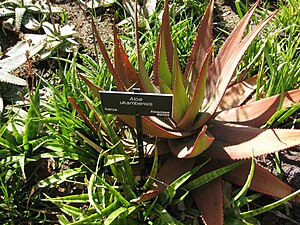Aloe ukambensis
| Aloe ukambensis | ||||||||||||
|---|---|---|---|---|---|---|---|---|---|---|---|---|

Aloe ukambensis |
||||||||||||
| Systematics | ||||||||||||
|
||||||||||||
| Scientific name | ||||||||||||
| Aloe ukambensis | ||||||||||||
| Reynolds |
Aloe ukambensis is a species of aloes in the subfamily of the Affodilla family (Asphodeloideae). The specific epithet ukambensis refers to the occurrence of the species in the former Ukambeni district in Kenya.
description
Vegetative characteristics
Aloe ukambensis grows without a stem or with a short stem, is solitary or usually sprouts and then forms small groups. The trunk is up to 30 centimeters long. The lanceolate, narrowed leaves form dense rosettes . The green to brownish green leaf blade is 20 to 25 inches long and 8 to 9 inches wide. There are numerous opaque white, elongated spots on the leaf surface, which are scattered or more or less arranged in interrupted transverse bands. The underside of the leaf is lighter and usually somewhat lined. There may be spots there. The piercing teeth on the leaf margin are 3 to 5 millimeters long and 10 to 15 millimeters apart. The leaf sap is dry, light orange-brown.
Inflorescences and flowers
The inflorescence consists of two to three branches and reaches a length of 50 centimeters. The dense, heady or almost heady grapes are 4 to 6 inches long and 6 inches wide. The ovoid-deltoid bracts have a length of 5 millimeters and are 2.5 millimeters wide. The bright, shiny red flowers are on 18 to 20 millimeter long peduncles . They are about 40 millimeters long and narrowed briefly at their base. At the level of the ovary , the flowers are 7 millimeters in diameter. They are slightly narrowed above this and then widened towards their mouth. Your tepals are not fused together over a length of 20 millimeters. The stamens and the pen stand out 3 to 5 millimeters from the flower.
genetics
The number of chromosomes is .
Systematics, distribution and endangerment
Aloe ukambensis is widespread in the southeast of Kenya on gneiss areas and rocky hill slopes at altitudes of 520 to 1370 meters.
The first description by Gilbert Westacott Reynolds was published in 1956.
Aloe ukambensis is in the endangered Red List species the IUCN as " Vulnerable (VU) ", d. H. classified endangered.
proof
literature
- Susan Carter , John J. Lavranos , Leonard E. Newton , Colin C. Walker : Aloes. The definitive guide . Kew Publishing, Royal Botanic Gardens, Kew 2011, ISBN 978-1-84246-439-7 , pp. 427 .
- Leonard Eric Newton: Aloe ukambensis . In: Urs Eggli (Hrsg.): Succulent lexicon. Monocotyledons . Eugen Ulmer, Stuttgart 2001, ISBN 3-8001-3662-7 , pp. 187 .
Individual evidence
- ↑ Urs Eggli, Leonard E. Newton: Etymological Dictionary of Succulent Plant Names . Springer, Berlin / Heidelberg 2010, ISBN 978-3-642-05597-3 , p. 247.
- ^ Journal of South African Botany . Volume 22, number 1, Kirstenbosch 1956, pp. 33-35.
- ↑ Aloe ukambensis in the endangered Red List species the IUCN 2012. Posted by: the Eastern Arc Mountains and Coastal Forests CEPF Plant Assessment Project Participants, 2009. Accessed October 18, 2012th
